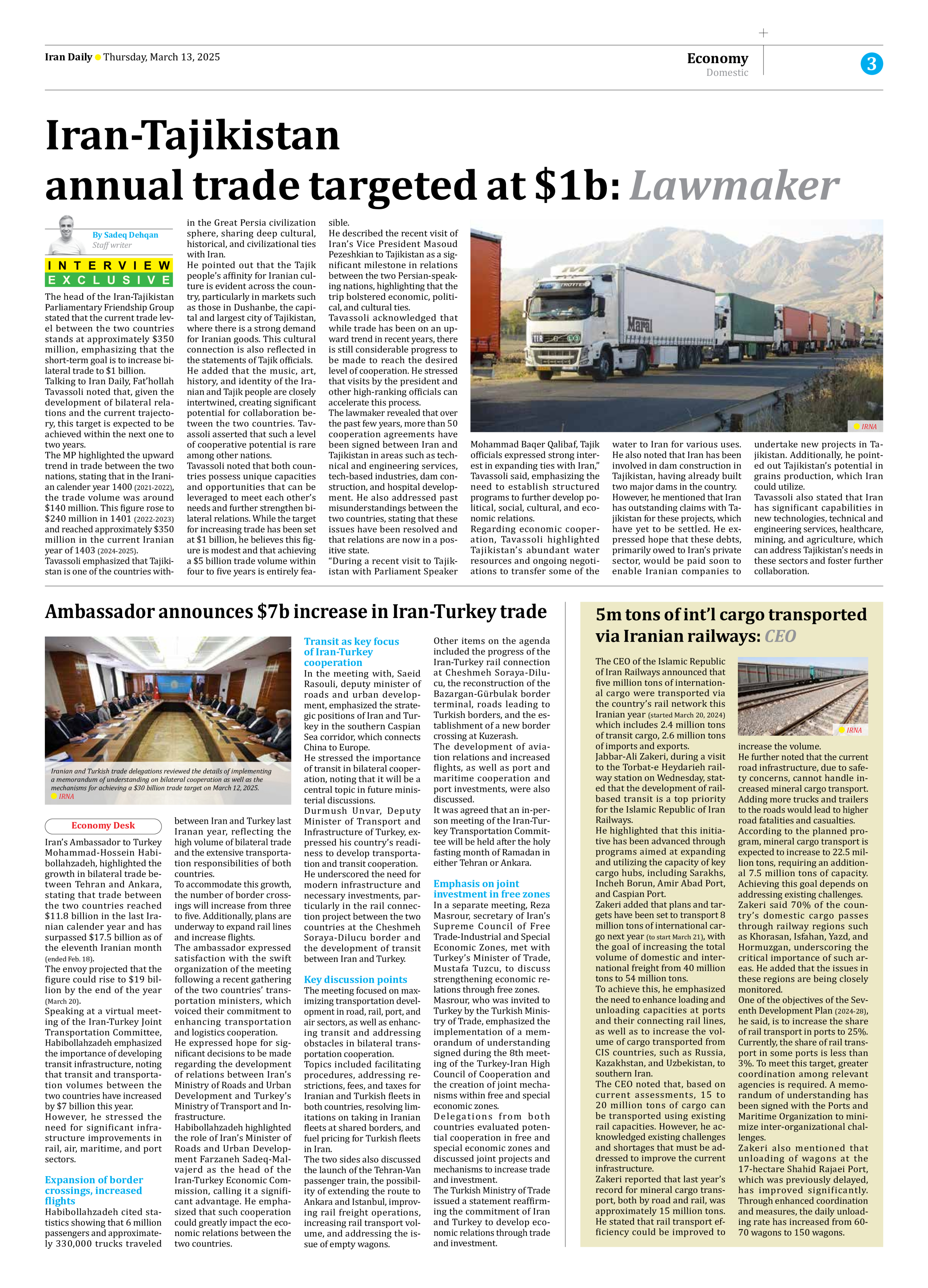
Iran-Tajikistan annual trade targeted at $1b: Lawmaker
By Sadeq Dehqan
Staff writer
The head of the Iran-Tajikistan Parliamentary Friendship Group stated that the current trade level between the two countries stands at approximately $350 million, emphasizing that the short-term goal is to increase bilateral trade to $1 billion.
Talking to Iran Daily, Fat’hollah Tavassoli noted that, given the development of bilateral relations and the current trajectory, this target is expected to be achieved within the next one to two years.
The MP highlighted the upward trend in trade between the two nations, stating that in the Iranian calender year 1400 (2021-2022), the trade volume was around $140 million. This figure rose to $240 million in 1401 (2022-2023) and reached approximately $350 million in the current Iranian year of 1403 (2024-2025).
Tavassoli emphasized that Tajikistan is one of the countries within the Great Persia civilization sphere, sharing deep cultural, historical, and civilizational ties with Iran.
He pointed out that the Tajik people’s affinity for Iranian culture is evident across the country, particularly in markets such as those in Dushanbe, the capital and largest city of Tajikistan, where there is a strong demand for Iranian goods. This cultural connection is also reflected in the statements of Tajik officials.
He added that the music, art, history, and identity of the Iranian and Tajik people are closely intertwined, creating significant potential for collaboration between the two countries. Tavassoli asserted that such a level of cooperative potential is rare among other nations.
Tavassoli noted that both countries possess unique capacities and opportunities that can be leveraged to meet each other’s needs and further strengthen bilateral relations. While the target for increasing trade has been set at $1 billion, he believes this figure is modest and that achieving a $5 billion trade volume within four to five years is entirely feasible.
He described the recent visit of Iran’s Vice President Masoud Pezeshkian to Tajikistan as a significant milestone in relations between the two Persian-speaking nations, highlighting that the trip bolstered economic, political, and cultural ties.
Tavassoli acknowledged that while trade has been on an upward trend in recent years, there is still considerable progress to be made to reach the desired level of cooperation. He stressed that visits by the president and other high-ranking officials can accelerate this process.
The lawmaker revealed that over the past few years, more than 50 cooperation agreements have been signed between Iran and Tajikistan in areas such as technical and engineering services, tech-based industries, dam construction, and hospital development. He also addressed past misunderstandings between the two countries, stating that these issues have been resolved and that relations are now in a positive state.
“During a recent visit to Tajikistan with Parliament Speaker Mohammad Baqer Qalibaf, Tajik officials expressed strong interest in expanding ties with Iran,” Tavassoli said, emphasizing the need to establish structured programs to further develop political, social, cultural, and economic relations.
Regarding economic cooperation, Tavassoli highlighted Tajikistan’s abundant water resources and ongoing negotiations to transfer some of the water to Iran for various uses. He also noted that Iran has been involved in dam construction in Tajikistan, having already built two major dams in the country.
However, he mentioned that Iran has outstanding claims with Tajikistan for these projects, which have yet to be settled. He expressed hope that these debts, primarily owed to Iran’s private sector, would be paid soon to enable Iranian companies to undertake new projects in Tajikistan. Additionally, he pointed out Tajikistan’s potential in grains production, which Iran could utilize.
Tavassoli also stated that Iran has significant capabilities in new technologies, technical and engineering services, healthcare, mining, and agriculture, which can address Tajikistan’s needs in these sectors and foster further collaboration.







